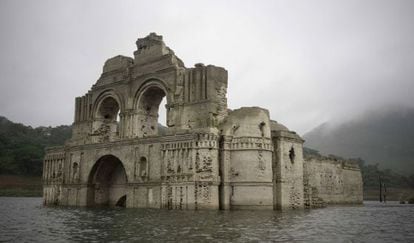Historic church resurfaces as drought dries up Mexico’s rivers
Low rainfall sees immersed 16th-century temple reemerge in Chiapas waterway


The fast-flowing rivers of southeast Mexico hide valuable treasure. Dropping water levels caused by lower-than-average rainfall have revealed the remains of a 16th-century church built by Dominican monks in the north of what is now the state of Chiapas.
The Quechula Church is 61 meters long and has been under water since 1966 when the Malpaso Dam was completed on the Grijalva River.
When water levels drop, the local fishermen turn into guides, taking tourists out to admire the remains
Water levels along the 600-kilometer waterway – the country’s second longest – are now critically low. They have been decreasing since May as a result of the impact of the current phase of the El Niño weather cycle, which has cut rainfall by half in this lush green area accustomed to torrential tropical storms.
Four dams depend on the Grijalva River, including Malpaso Dam, which serves an important hydroelectric plant that provides energy for several southeastern states.
Video: Inside the reemerged church (Spanish voiceover).
In August, the river’s water level was 11 meters below average and may have fallen far further since then as experts say the church can only be seen when it dips below 25 meters. The last time the church emerged was in 2002 when several worshipers walked to the building to celebrate a Mass.
Carlos Navarrete, an architect who wrote a report on the remains of the church for the Mexican government, says the building was abandoned between 1773 and 1776 after a series of plagues struck the communities of the region that is today inhabited by the indigenous Zoque people.
Before the completion of the dam in 1966, there was a small village near the church, a community of four neighborhoods, each one named after a saint. Relatives of the former residents say the church was known as the Iglesia de Santiago.
When water levels drop, the local fishermen turn into guides, taking curious tourists out to admire the remains of the old church in their small boats. Some of them say an earthquake destroyed one of the 10-foot walls in the 1940s.
English version by Dyane Jean François.










































